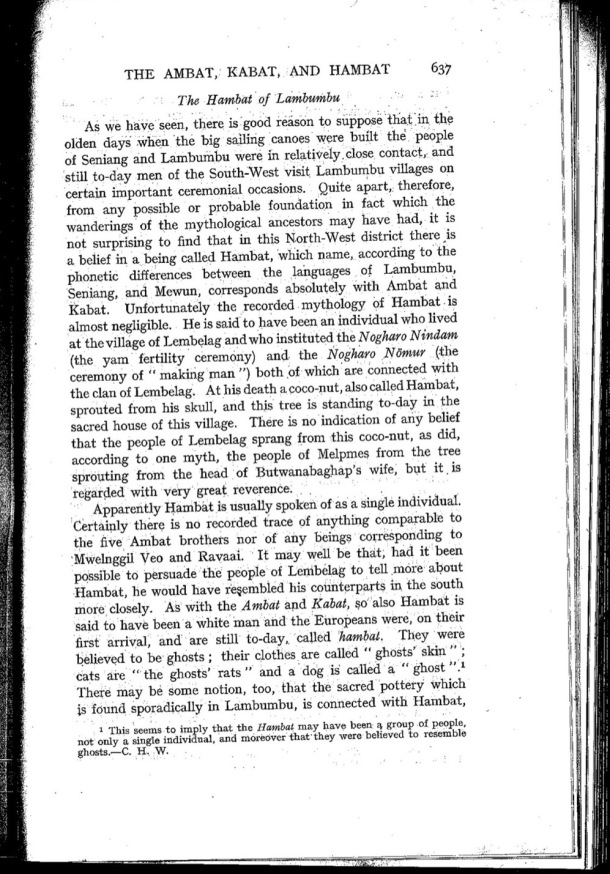|
|  [Note: this transcription was produced by an automatic OCR engine]
THE AMBAT, KABAT, AND HAMBAT 637
The Hambat of Lambumbu _
As we have seen, there isgood REASON to suppos-e’th'a_’t'in the
olden days when the big sailing canoes were built the people
of Seniang and Larnbumbu were in relativelyclose contact, and
still to-day men of the South-West visit Lamburnbu villages on
certain important ceremonial occasions. Quite apart, therefore,
from any possible or probable foundation in fact which the
wanderings of the mythological ancestors may have had, it is
not surprising to ï¬Ånd that in this North—West district there ‘is
a belief in a being called Hmnbat, which name, according to the
phonetic differences between the languages oi Lambumbu,
Seniang, and Mewun, corresponds absolutely with Amhat and
Kabat. Unfortunately the recorded mythology of Hanibat is
almost negligible. He is said to have been an individual who lived
at thevillage of Lcmbelag and who instituted the N ogharo Nimlam
(the yam fertility ceremony) and the Nogharo Nï¬Åmur (the
ceremony of " making rnan ") both of which are connected with
the clan of Lembelag. At his death acoco-nut, also called Hambat,
sprouted from his skull, and this tree is standing to-day i.n the
sacred house of this village. There is no indication of any belief
that the people of Lenibelag sprang irom this coco-nut, as did,
according to one myth, the people of Melpmes from the tree
sprouting from the head of Butwanabaghaps wife, but ityis
regarded with very great reverence. y
Apparently Hambat is usually spoken of as a single individual.
Certainly there is no recorded trace of anything comparable to
the five Ambat brothers nor of any beings corresponding to
'Mwelnggil Veo and Ravaai. It may well be that, had it been
possible to persuade the people of Lembclag to tell more about
Hambat, he would have resembled his counterparts in the south
more closely. As with the Ambat and Kabat, so’ also Hambat is
said to have been a white man and the Europeans were, on their
ï¬Årst arrival, and are still to-day, called hambal. They were
believed to be ghosts ; their clothes are called " ghosts’ skin " ;
cats are " the ghosts’ rats" and a dog is called a “ ghost "J
There may be some notion, too, that the sacred pottery which
is found sporadically in Lambumbu, is connected with Hambat,
1 T1is seems to im ly that the Humbat may have been 4 group of peOyle,
not only 3 single indivigual, and moreover thatfthey were believed to resemble
gh0st.s.—C. H. W.
K
if
l.
U
ilj
~i
i:
!
ii
,_
I Y
*
i
|